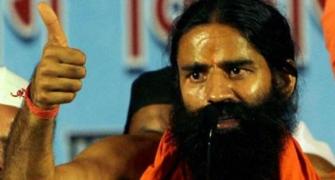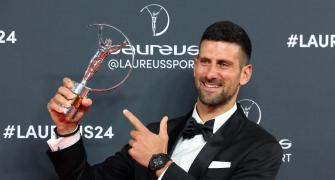The two battle it out in the controversial but lucrative fairness cream market, spark a fresh bout of aggression in the war between the brands
Illustration: Uttam Ghosh/Rediff.com
Hindustan Unilever (HUL) and Emami are at loggerheads yet again - this time over the socially pilloried but hugely popular, fairness creams category.
Emami has taken objection to the latest advertising for ‘Men’s Fair & Lovely’ by HUL, alleging that it tarnishes the image of its Fair & Handsome brand for men’s fairness creams.
While a court order has taken the offending advertisement off air, many are surprised by the renewed aggression in the category and ask if this is a precursor to pitched battles in the future.
 This is not the first time the two have clashed; the last time HUL and Emami fought over Fair & Handsome was in 2017 when the Advertising Standard Council of India (ASCI) dismissed HUL’s complaints about the claims made by Emami for its face wash.
This is not the first time the two have clashed; the last time HUL and Emami fought over Fair & Handsome was in 2017 when the Advertising Standard Council of India (ASCI) dismissed HUL’s complaints about the claims made by Emami for its face wash.
Back in 2009, the Calcutta civil court restrained HUL from running an advertising campaign for Vaseline, which Emami alleged, was disparaging towards its Boro Plus brand.
Advertising campaigns that satirize competing or leading brands in a category or demean the market leader are a remnant from advertising’s hoary past, reminiscent of the cola wars of the 1990s when Coca Cola and PepsiCo engaged in such battles.
Perhaps the most memorable was the ‘Nothing official about it’ campaign during the 1996 Cricket World Cup.
Even though Coca-Cola was a sponsor, PepsiCo had cricketers plumping for its brand with a punch line that took a dig at Coke’s official sponsor status.
Coca-Cola responded by pitting Thums Up against Pepsi and a series of controversial ads followed.
However, the cola majors have charted distinct advertising territories of their own since then.
But as Ramesh Thomas, president at brand value management firm, Equitor, puts it, when one category vacates comparative advertising, another segment rushes to fill the gap.
“Comparative advertising helps in grabbing immediate attention especially for a newcomer”, he says.
According to a senior executive who preferred to stay anonymous, such ads are deadly in the near-term when used wittingly and aimed at the market leader.
And this was why Emami, the market leader in this segment, sought a stay order at the early stage of the campaign.
Thomas sees no harm in such advertising but adds that companies must use the platform to drive home their advantages and values, not just run down the competitor.
He cites the example of Titan, which had taken on market leader HMT when it rolled out its watches.
Choose a watch as you would your jewellery, the ads said, implying that a watch need not look dull to be effective.
“The product was the same but the positioning of these two brands was diametrically opposite,” Thomas adds.
Harish Bijoor, CEO at Harish Bijoor Consults believes that comparative advertising never goes out of fashion.
“As long as consumers are comparative by nature, the ads will also be so,” he says.
However many believe that such advertising is usually favoured by new brands and those at the bottom of the price pyramid.
While such pot-shots at a competitor are more lucrative for a brand that is still making its mark, the advantages diminish as one moves up the price ladder.
Bijoor argues that in the lower end of the pricing pyramid, consumers are conscious about price and competing brands.
“For premium brands, consumers are aware of the brand value and the ‘show off factor’ and comparative advertising isn’t needed,” he adds.
Over the years, responsible and respectable marketers have indulged in such advertising and it will go on as long as the consumer continues to compare brands, he adds.
Industry officials point out that it is usual for a new brand to either talk about a unique value proposition or directly attack competition citing its own product to be superior. “Patanjali came out with a similar campaign against several established brands”, the official said.
Recently, Puro salttook on the entire set of established brands alleging that the common salt used in homes is chemically bleached while claiming its own product was not.
Such advertising however comes with a sell-by date. Over the years, a new brand has to demonstrate the prowess of its own value instead of pulling the competition down.
In some cases comparative advertising can lead to long term changes in the category.
For example, Fogg deodorant took on other deo brands alleging that competitive deos are filled with gas but not its own. Soon the rest of the brands joined the bandwagon.
Brand Strategy Advisor Prabhakar Mundkur points out, “Even if a product started with a physical functional differentiator, it didn't take long for the competition to catch up, so the claim was short lived anyway.”
Comparative advertising has been one of the weak ploys of the FMCG sector precisely because the segment is “skating on thin ice when it makes such comparative claims,” he adds.










